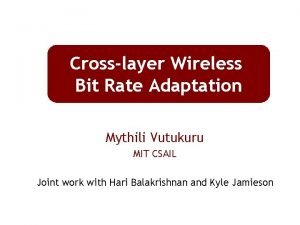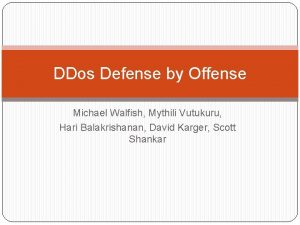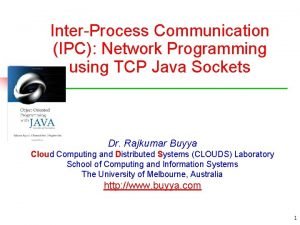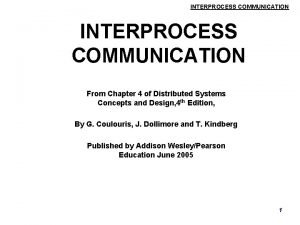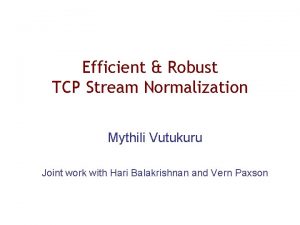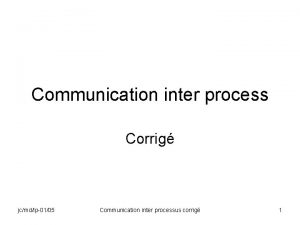Lecture 6 Inter Process Communication IPC Mythili Vutukuru








- Slides: 8

Lecture 6: Inter Process Communication (IPC) Mythili Vutukuru IIT Bombay

Inter Process Communication (IPC) • Processes do not share any memory with each other • Some processes might want to work together for a task, so need to communicate information • IPC mechanisms to share information between processes 2

Shared Memory • Processes can both access same region of memory via shmget()system call • int shmget ( key_t key, int size, int shmflg ) • By providing same key, two processes can get same segment of memory • Can read/write to memory to communicate • Need to take care that one is not overwriting other’s data: how? 3

Signals • A certain set of signals supported by OS – Some signals have fixed meaning (e. g. , signal to terminate process) – Some signals can be user-defined • Signals can be sent to a process by OS or another process (e. g. , if you type Ctrl+C, OS sends SIGINT signal to running process) • Signal handler: every process has a default code to execute for each signal – Exit on terminate signal • Some signal handlers can be overridden to do other things 4

Sockets • Sockets can be used for two processes on same machine or different machines to communicate – TCP/UDP sockets across machines – Unix sockets in local machine • Communicating with sockets – Processes open sockets and connect them to each other – Messages written into one socket can be read from another – OS transfers data across socket buffers 5

Pipes • Pipe system call returns two file descriptors – Read handle and write handle – A pipe is a half-duplex communication – Data written in one file descriptor can be read through another • Regular pipes: both fd are in same process (how it is useful? ) – Parent and child share fd after fork – Parent uses one end and child uses other end • Named pipes: two endpoints of a pipe can be in different processes • Pipe data buffered in OS buffers between write and read 6

Message Queues • Mailbox abstraction • Process can open a mailbox at a specified location • Processes can send/receive messages from mailbox • OS buffers messages between send and receive 7

Blocking vs. non-blocking communication • Some IPC actions can block – Reading from socket/pipe that has no data, or reading from empty message queue – Writing to a full socket/pipe/message queue • The system calls to read/write have versions that block or can return with an error code in case of failure – A socket read can return error indicating no data to be read, instead of blocking 8

